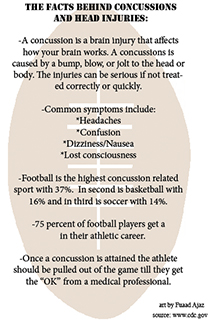Successive concussions have high school athletes concerned

December 4, 2015
The synchronized gasp of the crowd, the blur of the trainers on the field. Looks of worry and panic are exchanged in the stands. These types of encounters can be found at nearly every sporting event. Concussions make up of 10% of all high school athletic injuries. Every year, more than 60,000 U.S. high school athletes sustain a concussion. Bowie very own students are included in these statistics.
“They can be pretty serious,” sophomore JV football player Caleb Bohm said. “Even if the concussion is mild, it’s nothing to mess around with. When you play football, concussions aren’t really anything out of the ordinary so it’s not that shocking to anyone when someone takes a nasty hit then gets diagnosed with one.”
The amount of teenagers ages 14-19 that have had to go to the ER for concussions has gone up 200 percent in the last decade alone.
“When I got my concussion after I got hit, my vision was blurry, and I had a throbbing headache,” Bohm said. “The trainers from the other team’s sideline came up to me and performed a bunch of tests that were supposed to determine if I had the symptoms of someone who obtained a concussion would have.”
High school football is very dangerous when it comes to head injuries nearly 37 percent of sports related concussions come from football, but football is not the only sport that poses as a threat for concussions. Soccer makes up about 14 percent of concussions.
Heading the ball, falling down, head on head collision and getting kicked in the head by cleats are all ways soccer players obtain concussions.
“I got kicked in head during a game when I was playing goalie,” sophomore soccer player Kesiah Sulzbach said. “Doc T the trainer diagnosed me with one [a concussion] at the game and the AXON test verified it. Doc T had me count back from 100 by threes and I had to follow her finger with my eyes.”
Last year, during the spring season on the Bowie girl’s soccer team, there were over five concussions.
“I was told to lay off of all sports for two months,” Sulzbach said. “Once I was cleared by my doctor, I had to go through the AISD physical therapy protocol. That meant I had to complete a series of exercises in a certain amount of time without getting a headache. If I got a headache, I would have to come back the next day and try the same exercises again and repeat it until I didn’t get pains anymore.”
Even though concussions have the most effect on the person who physically gets the concussion when involved in a team sport the outcome includes teams as a whole.
“As a team, you depend on your fellow teammates,” varsity soccer coach Hoffman-Howell said. “So when you have a player out, everyone has to adjust to the loss accordingly.”
Because concussions in high school sports are getting progressively worse the goal of the new AISD concussion regulation is to reduce the amount of student getting concussions. It is already proving to be more beneficial as the concussion rates for high school athletes has stopped escalating.
“I had to work my butt off to get to where I am at this point and I am definitely more cautious after having a personal experience with a head injury. Safety is now my top priority when I hear the game whistle,” Sulzbach said.









